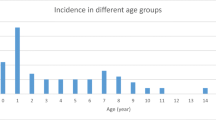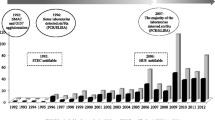Abstract
Background
Shiga toxin-producing Escherichia coli (STEC) infection is the most common cause of hemolytic uremic syndrome (HUS). Only few studies correlated serotypes and stx genotypes with disease severity. This study aimed to update STEC serotypes, stx genotypes, and virulence factors (eae and ehxA) in a cohort of patients with STEC-HUS and investigate whether they influence the severity of disease.
Methods
In this multicentric study, children hospitalized between 2005 and 2016 with STEC-HUS confirmed by the National Reference Laboratory were included. Serotypes (O157, O145, O121, and others), stx genotypes (stx1a, stx2a, stx2c, stx2d, and others), and virulence factors were analyzed, and their association with dialysis requirement (>10 days); severe neurological, cardiovascular, and/or bowel involvement; and death was assessed.
Results
The records of 280 patients were reviewed; 160 females, median age 21 months (IQR18m). STEC O157 was isolated in 206 (73.6%) patients, O145 in 47 (16.8%), O121 in 15 (5.4%), and other serotypes in 12 (4.2%). The stx2a/2c genotype was carried by 179 (63.9%) strains, stx2a by 94 (33.6%), stx1a/stx2a by five (1.8%), and stx1a only by two (0.7%). All strains except six harbored eae and ehxA genes. Fifty-nine (21.1%) patients had severe neurological involvement, 29 (10.4%) severe bowel injury, 14 (5%) cardiovascular involvement, 53 (18.9%) required > 10 days of dialysis, and 12 (4.3%) died. Neither serotypes nor stx genotypes detected were significantly linked to severity.
Conclusions
Serotype O157 and virulence stx2a/2c, eae, ehxA genotype are prevalent in Argentina, and no relationship was found between severity and serotypes and genotypes of STEC detected.

Similar content being viewed by others
References
Alconcher LF, Coccia PA, Suarez ADC, Monteverde ML, Perez Y, Gutiérrez MG, Carlopio PM, Missoni ML, Balestracci A, Principi I, Ramírez FB, Estrella P, Micelli S, Leroy DC, Quijada NE, Seminara C, Giordano MI, Hidalgo Solís SB, Saurit M, Caminitti A, Arias A, Rivas M, Risso P, Liern M (2018) Hyponatremia: a new predictor of mortality in patients with Shiga toxin-producing Escherichia coli hemolytic uremic syndrome. Pediatr Nephrol 33:1791–1798. https://doi.org/10.1007/s00467-018-3991-6
Scheiring J, Andreoli SP, Zimmerhackl LB (2008) Treatment and outcome of Shiga-toxin-associated hemolytic uremic syndrome (HUS). Pediatr Nephrol 23:1749–1760. https://doi.org/10.1007/s00467-008-0935-6
Ministerio de Salud de la Nación Argentina. Boletín Integrado de Vigilancia. N° 477 – SE 50 – 2019. Página 47. [Consulta: 11 de Junio 2020. Disponible en: https://www.argentina.gob.ar/sites/default/files/201912-biv_477.pdf]
Monteverde ML, Paz M, Ibáñez JP, Chaparro AB, Solernou V, Sager C, Tessi C, Locane F (2020) Kidney transplantation in children with CAKUT and non-CAKUT causes of chronic kidney disease: Do they have the same outcomes? Pediatr Transplant 24:e13763. https://doi.org/10.1111/petr.13763
Ylinen E, Salmenlinna S, Halkilahti J, Jahnukainen T, Korhonen L, Virkkala T, Rimhanen-Finne R, Nuutinen M, Kataja J, Arikoski P, Linkosalo L, Bai X, Matussek A, Jalanko H, Saxén H (2020) Hemolytic uremic syndrome caused by Shiga toxin-producing Escherichia coli in children: incidence, risk factors, and clinical outcome. Pediatr Nephrol 35:1749–1759. https://doi.org/10.1007/s00467-020-04560-0
Brandal LT, Wester AL, Lange H, Løbersli I, Lindstedt BA, Vold L, Kapperud G (2015) Shiga toxin-producing Escherichia coli infections in Norway, 1992-2012: characterization of isolates and identification of risk factors for haemolytic uremic syndrome. BMC Infect Dis 15:324. https://doi.org/10.1186/s12879-015-1017-6
Gerber A, Karch H, Allerberger F, Verweyen HM, Zimmerhackl LB (2002) Clinical course and the role of Shiga toxin-producing Escherichia coli infection in the hemolytic-uremic syndrome in pediatric patients, 1997-2000, in Germany and Austria: a prospective study. J Infect Dis 186:493–500. https://doi.org/10.1086/341940
Nüesch-Inderbinen M, Morach M, Cernela N, Althaus D, Jost M, Mäusezahl M, Bloomberg G, Stephan R (2018) Serotypes and virulence profiles of Shiga toxin-producing Escherichia coli strains isolated during 2017 from human infections in Switzerland. Int J Med Microbiol 308:933–939. https://doi.org/10.1016/j.ijmm.2018.06.011
Karmali MA (2004) Infection by Shiga toxin-producing Escherichia coli: an overview. Mol Biotechnol 26:117–122. https://doi.org/10.1385/MB:26:2:117
Scheutz F, Teel LD, Beutin L, Piérard D, Buvens G, Karch H, Mellmann A, Caprioli A, Tozzoli R, Morabito S, Strockbine NA, Melton-Celsa AR, Sanchez M, Persson S, O'Brien AD (2012) Multicenter evaluation of a sequence-based protocol for subtyping Shiga toxins and standardizing Stx nomenclature. J Clin Microbiol 50:2951–2963. https://doi.org/10.1128/JCM.00860-12
Fuller CA, Pellino CA, Flagler MJ, Strasser JE, Weiss AA (2011) Shiga toxin subtypes display dramatic differences in potency. Infect Immun 79:1329–1337. https://doi.org/10.1128/IAI.01182-10
Russo LM, Melton-Celsa AR, Smith MA, Smith MJ, O’Brien AD (2014) Oral intoxication of mice with Shiga toxin type 2a (Stx2a) and protection by anti-Stx2a monoclonal antibody 11E10. Infect Immun 82:1213–1221. https://doi.org/10.1128/IAI.01264-13
Wadolkowski EA, Sung LM, Burris JA, Samuel JE, O'Brien AD (1990) Acute renal tubular necrosis and death of mice orally infected with Escherichia coli strains that produce Shiga-like toxin type II. Infect Immun 58:3959–3965. https://doi.org/10.1128/IAI.58.12.3959-3965.1990
Tarr GAM, Stokowski T, Shringi S, Tarr PI, Freedman S, Oltean HN, Rabinowitz PM, Chui L (2019) Contribution and interaction of Shiga toxin genes to Escherichia coli O157:H7 virulence. Toxins 11:607. https://doi.org/10.3390/toxins11100607
Ardissino G, Possenti I, Vignati C, Daprai L, Capone V, Brigotti M, Luini MV, Consonni D, Montini G (2020) Is Shigatoxin 1 protective for the development of Shigatoxin 2-related hemolytic uremic syndrome in children? Data from the ItalKid-HUS Network. Pediatr Nephrol 35:1997–2001. https://doi.org/10.1007/s00467-020-04697-y
LeBlanc JJ (2003) Implication of virulence factors in Escherichia coli O157:H7 pathogenesis. Crit Rev Microbiol 29:277–296. https://doi.org/10.1080/713608014
Ethelberg S, Olsen KE, Scheutz F, Jensen C, Schiellerup P, Enberg J, Petersen AM, Olesen B, Gerner-Smidt P, Mølbak K (2004) Virulence factors for hemolytic uremic syndrome, Denmark. Emerg Infect Dis 10:842–847. https://doi.org/10.3201/eid1005.030576
Rivas M, Miliwebsky E, Chinen I, Deza N, Leotta GA (2006) The epidemiology of hemolytic uremic syndrome in Argentina. Diagnosis of the etiologic agent, reservoirs and routes of transmission. Medicina (B Aires) 66 Suppl 3:27-32
Rivas M, Miliwebsky E, Chinen I, Roldán CD, Balbi L, García B, Fiorilli G, Sosa-Estani S, Kincaid J, Rangel J, Griffin PM, Case-Control Study Group (2006) Characterization and epidemiologic subtyping of Shiga toxin-producing Escherichia coli strains isolated from hemolytic uremic syndrome and diarrhea cases in Argentina. Foodborne Pathog Dis 3:88–96. https://doi.org/10.1089/fpd.2006.3.88
Ardissino G, Possenti I, Tel F, Testa S, Paglialonga F (2014) Time to change the definition of hemolytic uremic syndrome. Eur J Intern Med 25:e29. https://doi.org/10.1016/j.ejim.2013.12.002
Rivas M, Sosa-Estani S, Rangel J, Caletti MG, Vallés P, Roldán CD, Balbi L, Marsano de Mollar MC, Amoedo D, Miliwebsky E, Chinen I, Hoekstra RM, Mead P, Griffin PM (2008) Risk factors for sporadic Shiga toxin-producing Escherichia coli infections in children, Argentina. Emerg Infect Dis 14:763–771. https://doi.org/10.3201/eid1405.071050
Pianciola L, Rivas M (2018) Genotypic features of clinical and bovine Escherichia coli O157 strains isolated in countries with different associated-disease incidences. Microorganisms 6:36. https://doi.org/10.3390/microorganisms6020036
Mody RK, Luna-Gierke RE, Jones TF, Comstock N, Hurd S, Scheftel J, Lathrop S, Smith G, Palmer A, Strockbine N, Talkington D, Mahon BE, Hoekstra RM, Griffin PM (2012) Infections in pediatric postdiarrheal hemolytic uremic syndrome: factors associated with identifying Shiga toxin-producing Escherichia coli. Arch Pediatr Adolesc Med 166:902–909. https://doi.org/10.1001/archpediatrics.2012.471
Schifferli A, von Vigier RO, Fontana M, Spartà G, Schmid H, Bianchetti MG, Rudin C, Swiss Pediatric Surveillance Unit (2010) Hemolytic-uremic syndrome in Switzerland: a nationwide surveillance 1997-2003. Eur J Pediatr 169:591–598. https://doi.org/10.1007/s00431-009-1079-9
Loconsole D, Giordano M, Centrone F, Accogli M, Casulli D, De Robertis AL, Morea A, Quarto M, Parisi A, Scavia G, Chironna M, On behalf of the Bloody Diarrhea Apulia Working Group (2020) Epidemiology of Shiga toxin-producing Escherichia coli infections in Southern Italy after implementation of symptom-based surveillance of bloody diarrhea in the pediatric population. Int J Environ Res Public Health 17:5137. https://doi.org/10.3390/ijerph17145137
Elliott EJ, Robins-Browne RM, O'Loughlin EV, Bennett-Wood V, Bourke J, Henning P, Hogg GG, Knight J, Powell H, Redmond D, Contributors to the Australian Paediatric Surveillance Unit (2001) Nationwide study of haemolytic uraemic syndrome: clinical, microbiological, and epidemiological features. Arch Dis Child 85:125–131. https://doi.org/10.1136/adc.85.2.125
Petro CD, Trojnar E, Sinclair J, Liu ZM, Smith M, O'Brien AD, Melton-Celsa A (2019) Shiga toxin type 1a (Stx1a) reduces the toxicity of the more potent Stx2a in vivo and in vitro. Infect Immun 87:e00787–e00718. https://doi.org/10.1128/IAI.00787-18
Ardissino G, Daccò V, Testa S, Civitillo CF, Tel F, Possenti I, Belingheri M, Castorina P, Bolsa-Ghiringhelli N, Tedeschi S, Paglialonga F, Salardi S, Consonni D, Zoia E, Salice P, Chidini G (2015) Hemoconcentration: a major risk factor for neurological involvement in hemolytic uremic syndrome. Pediatr Nephrol 30:345–352. https://doi.org/10.1007/s00467-014-2918-0
Mody RK, Gu W, Griffin PM, Jones TF, Rounds J, Shiferaw B, Tobin-D'Angelo M, Smith G, Spina N, Hurd S, Lathrop S, Palmer A, Boothe E, Luna-Gierke RE, Hoekstra RM (2015) Postdiarrheal hemolytic uremic syndrome in United States children: clinical spectrum and predictors of in-hospital death. J Pediatr 166:1022–1029. https://doi.org/10.1016/j.jpeds.2014.12.064
Pacheco AR, Lazarus JE, Sit B, Schmieder S, Lencer WI, Blondel CJ, Doench JG, Davis BM, Waldor MK (2018) CRISPR screen reveals that EHEC’s T3SS and Shiga toxin rely on shared host factors for infection. mBio 9:e01003-18. https://doi.org/10.1128/mBio.01003-18
Acknowledgements
We thank Eugenia Elorza and Fernanda Villarreal for their assistance in the statistical analysis.
Author information
Authors and Affiliations
Corresponding author
Ethics declarations
This was a multicentric, observational, retrospective, and cross-sectional study. The Review Boards and Ethics Committees of the participating centers approved this study. The requirement to obtain informed consent was waived by the institutional review boards.
Conflict of interest
The authors declare no competing interests.
Additional information
Publisher’s note
Springer Nature remains neutral with regard to jurisdictional claims in published maps and institutional affiliations.
Rights and permissions
About this article
Cite this article
Alconcher, L.F., Balestracci, A., Coccia, P.A. et al. Hemolytic uremic syndrome associated with Shiga toxin-producing Escherichia coli infection in Argentina: update of serotypes and genotypes and their relationship with severity of the disease. Pediatr Nephrol 36, 2811–2817 (2021). https://doi.org/10.1007/s00467-021-04988-y
Received:
Revised:
Accepted:
Published:
Issue Date:
DOI: https://doi.org/10.1007/s00467-021-04988-y




